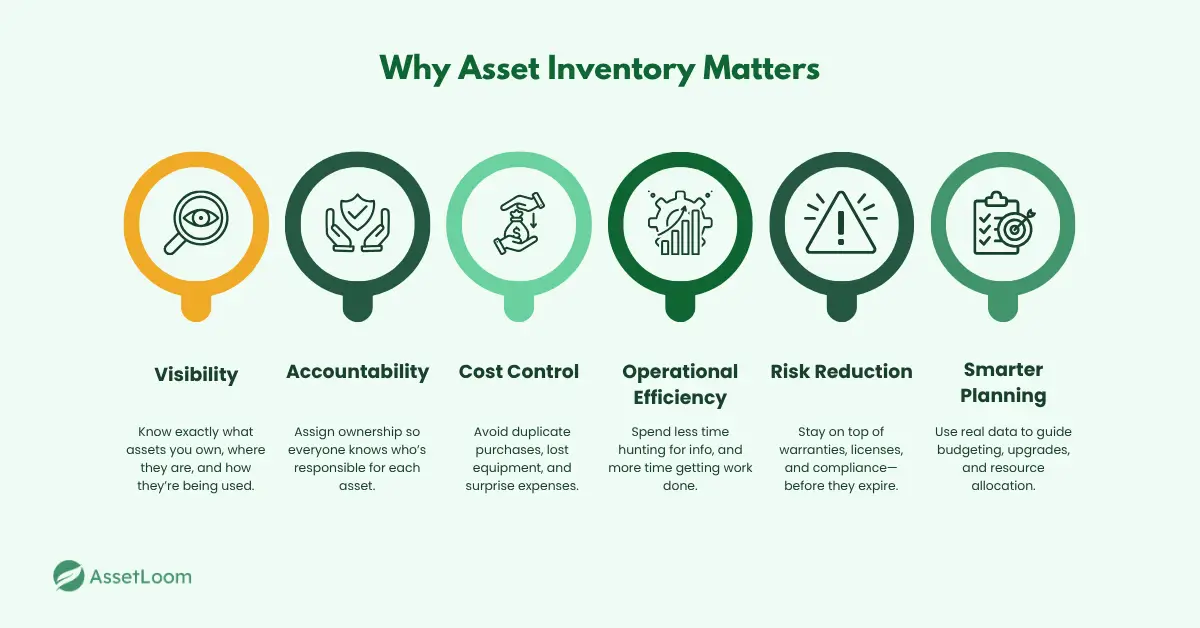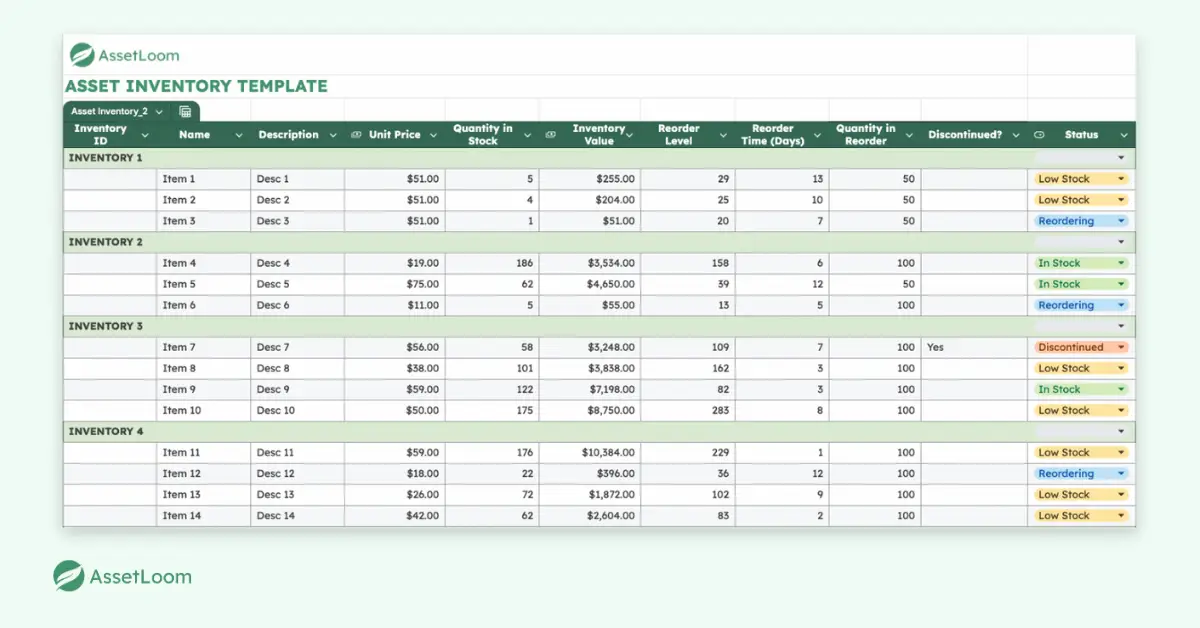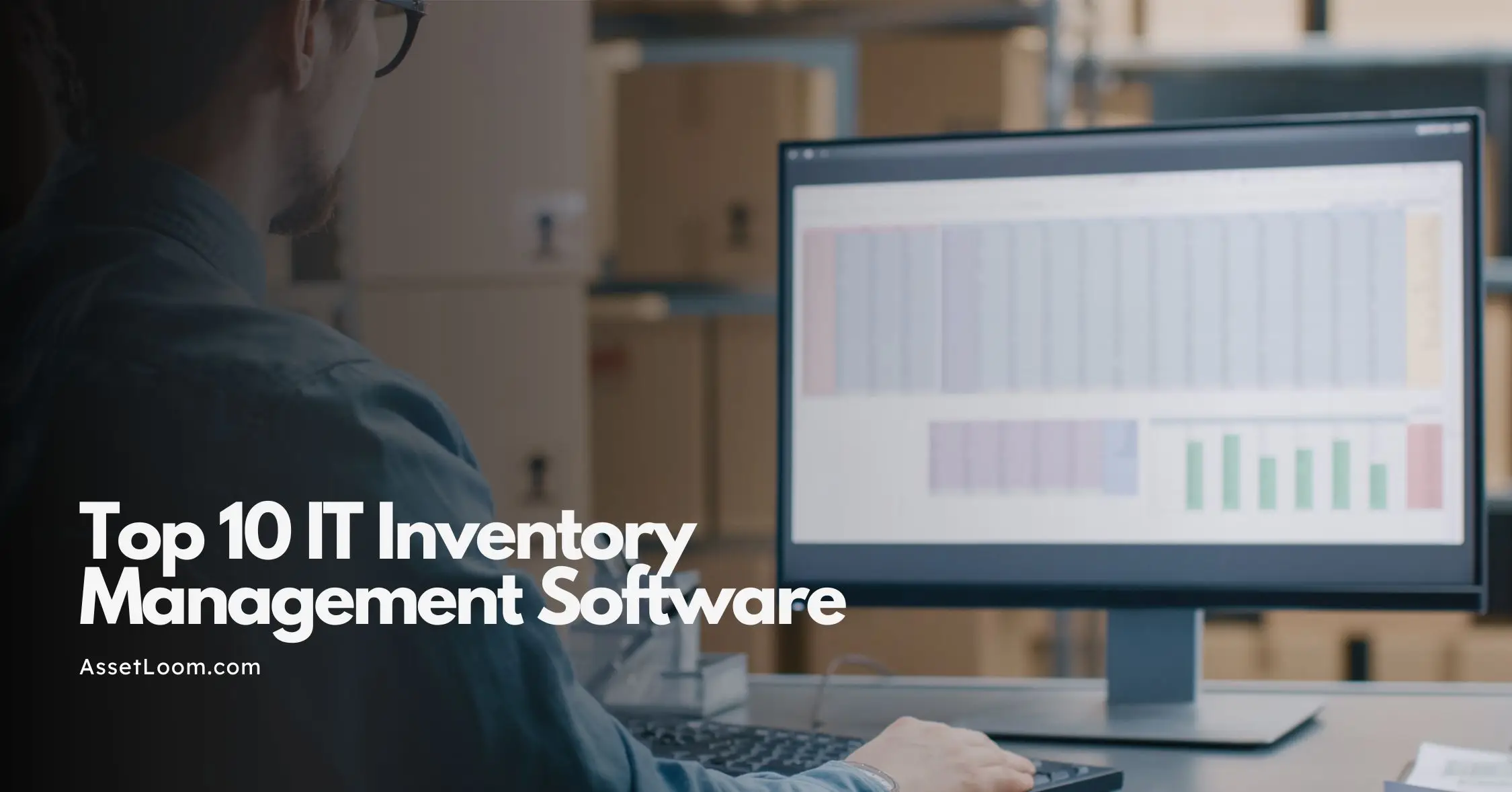Free Asset Inventory Template Excel Download
Download a free Excel asset inventory template to simplify tracking hardware, software, and office equipment. Perfect for small teams and IT admins.
Assets disappear. Licenses expire. No one knows who took the second monitor.
Sound familiar?
You don’t need fancy software to fix it—just one solid spreadsheet that’s built to keep your assets in check.
This free Excel template is clean, smart, and ready to use. It’s not just a tracker. It’s your first step toward asset sanity.
Let’s take a look inside.
What Is an Asset Inventory—and Why It Actually Matters
An asset inventory isn’t just a list of equipment—it’s the backbone of how your business keeps track of everything it owns. From laptops, monitors, and phones to software licenses, network devices, and even office furniture, it captures all the important details in one place.
A good asset inventory shows you:
- What assets you have: So you’re not buying duplicates or missing critical gear.
- Where they are: Whether on-site, remote, or in storage, knowing the location saves time and confusion.
- Who’s responsible: Assigning ownership helps with accountability and support.
- When maintenance or warranties expire, staying ahead avoids costly downtime or surprises.
Managing an asset inventory may seem simple, but challenges in IT asset inventory management—such as outdated records, scattered data, and unclear ownership, make it more complex than it appears.
Why is this so important? Without an accurate inventory:
- Assets can go missing or get misused
- You risk compliance and audit failures
- Renewals and upgrades get overlooked, leading to wasted money
- Teams spend hours hunting down information instead of focusing on their work
In short, a clear, up-to-date asset inventory reduces risks, saves money, and keeps your business running smoothly. And while some companies invest in expensive tools, it all starts with one smart, well-designed spreadsheet.

Common Challenges Teams Face with Asset Inventory
If you've ever tried to keep track of company equipment, you know it sounds simple—until it isn’t. Asset inventory can get messy fast, even with a team that’s doing their best. Here are some of the most common issues that come up, and why they matter more than you might think.
1. Things Don’t Get Updated
This is probably the most common problem: the inventory starts out strong, but over time, it slips. A laptop gets handed off to someone new and no one logs it. An old printer is thrown out, but still shows up as “active.” Before you know it, your spreadsheet is out of sync with reality—and it becomes harder and harder to trust what’s in there.
2. The Info Lives in Too Many Places
One person has a spreadsheet, someone else keeps notes in an email, and another team is tracking things in their own system. Sound familiar? When asset data is scattered, no one has the full picture. That leads to duplicate purchases, missing records, and a whole lot of wasted time just trying to answer basic questions like: “Where is that monitor?” or “Did we already buy that software?”
3. No One Really Owns It
Assets fall through the cracks when no one is responsible for keeping tabs on them. Maybe it was assigned to someone who left, or it just never had a clear owner to begin with. Without accountability, updates get missed and gear goes untracked. It’s not about blaming people—it’s about setting up a process that makes ownership part of the system.
4. It’s All Manual—and That Slows Everyone Down
Typing everything into a spreadsheet by hand might work for a while, but it doesn’t scale. People get busy, entries are skipped, or numbers are typed wrong. And even when it’s done well, it’s slow. Over time, those little delays and errors add up, and you’re left with a file that nobody really wants to rely on.
5. Renewals and Warranties Slip Through the Cracks
Most teams don’t have a great system for tracking software licenses or warranty expirations—and it shows. One day, something breaks or a subscription lapses, and suddenly you’re dealing with unexpected downtime or surprise costs. It’s not that people don’t care—it’s that there’s no easy way to stay on top of it all.
6. Remote Work Makes It Even Harder
When everyone worked in the same office, it was easier to keep track of where things were. Now? Equipment is spread across homes, coworking spaces, and storage closets. Without a centralized view, it’s tough to know what’s out there, let alone who has it or whether it’s being used.
So What’s the Cost?
A little disorganization might not seem like a big deal at first—but over time, it adds up. Teams end up spending hours looking for answers. Equipment goes missing. Budgets get wasted. And when audits or compliance reviews come around, you’re left scrambling. It’s frustrating, stressful, and totally avoidable.
A Simple Way to Get Back on Track
The good news? You don’t need expensive software to fix this. A clean, easy-to-use Excel template can go a long way. It gives you one place to keep everything organized—what you have, where it is, who’s using it, and when it needs attention. It’s not about being perfect—it’s about having a system that works.
What’s Inside This Asset Inventory Template
This template isn’t just a blank table—it’s built with real asset tracking in mind, so you’re not starting from scratch.
Here’s what you’ll find inside:
- Inventory ID & Name: Unique identifiers for each item, making them easy to search and reference.
- Description: A brief summary to distinguish items, especially helpful for similar products.
- Unit Price: The cost per item, used to calculate total inventory value.
- Quantity in Stock: This shows how many units are currently available.
- Inventory Value: Automatically calculated as Unit Price × Quantity in Stock for real-time valuation.
- Reorder Level: The minimum stock threshold that triggers a reorder.
- Reorder Time (Days): Average time needed to restock the item—helps avoid supply gaps.
- Quantity in Reorder: Number of units to reorder once the level is triggered.
- Discontinued?: Marks items that are no longer active or in circulation.
- Status: Auto-filled field showing current state—In Stock, Low Stock, Reordering, or Discontinued—based on live inventory data.
The layout is clean, the fields are clear, and dropdowns help keep everything consistent. Whether you're tracking five assets or five hundred, this template gives you structure that scales.
Download the Free Asset Inventory Template
Ready to get organized? You can download the template below and start tracking your assets immediately—no signups, no fluff, just a clean, practical file that works.
It comes pre-filled with example entries to guide you, plus dropdown menus that make updates quick and consistent. You can easily edit, expand, or customize it to suit your team’s needs.
Download the Asset Inventory TemplateWhether you’re building your first inventory or cleaning up a messy one, this template gives you the foundation to do it right.

Start Simple, Stay in Control
You don’t need complex systems to get your asset inventory under control. You just need a tool that’s clear, consistent, and built for real work.
This template helps you skip the chaos and start tracking what matters—devices, licenses, responsibilities, and timelines—all in one place.
It’s simple, yes. But the impact? Huge. Better visibility. Fewer surprises. Smarter decisions.
So download the template, make it your own, and take the first step toward an asset inventory that actually works for you.

Related Blogs
Subscribe for Expert Tips and Updates
Receive the latest news from AssetLoom. right in your inbox

